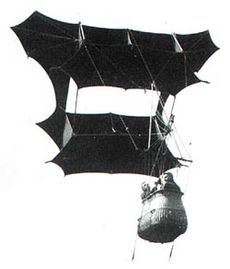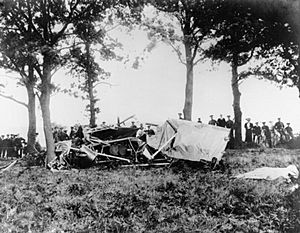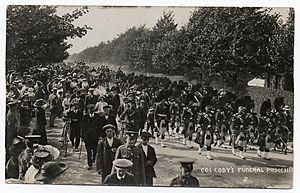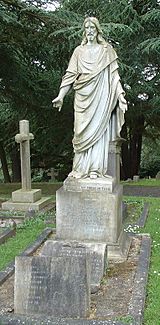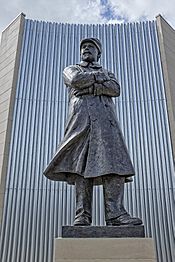Samuel Franklin Cody facts for kids
Quick facts for kids
Samuel Franklin Cody
|
|
|---|---|
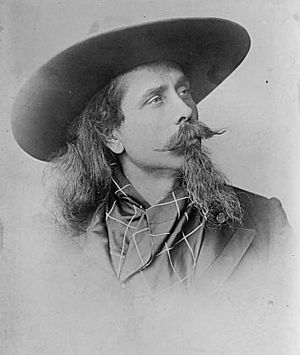
Samuel Franklin Cody in 1909
|
|
| Born | 6 March 1867 Davenport, Iowa, USA
|
| Died | 7 August 1913 (aged 46) Cove Common, Farnborough, United Kingdom
|
| Occupation | Showman, aviator, aircraft designer |
| Spouse(s) | Maud Maria Lee |
| Children | 4 |
Samuel Franklin Cowdery (later known as Samuel Franklin Cody; 6 March 1867 – 7 August 1913) was an American showman and a very early pioneer of flying machines. He was born in Davenport, Iowa, USA.
Cody is most famous for his work on large kites called Cody War-Kites. The British military used these kites before World War I to spot targets for their cannons, as a smaller option to large balloons. He was also the first person to fly an aeroplane built in Britain. This historic flight happened on 16 October 1908. Cody was a lively showman and was often mistaken for Buffalo Bill Cody, whose last name he took when he was young.
Contents
Cody's Amazing Kites
It's not fully clear why Cody became so interested in flying kites. He used to tell a story that a Chinese cook taught him about kites while they were traveling. However, it's more likely that his interest grew from his friendship with Auguste Gaudron, a balloon pilot he met at Alexandra Palace.
Cody quickly became interested in making kites that could fly very high and even carry a person. He and his friends, Leon and Vivian, started competing to build the biggest kites that could fly higher and higher.
Developing the War Kite
Cody used money from his shows to improve the Lawrence Hargrave double-cell box kite. He made it lift more weight by adding wings to its sides. He also created a clever way to fly many kites on one long line. This system could reach thousands of feet high or carry several people in a small basket. He got a patent for his design in 1901, and it became known as the Cody kite.
At that time, balloons were used for checking the weather and for military spying. But balloons could only be used when the wind was light. Cody realized that kites, which need stronger winds to fly, could be used in more types of weather. His kites were soon used for meteorology (the study of weather), and he became a member of the Royal Meteorological Society.
Kites for the Military
In December 1901, Cody offered his kite design to the War Office (the British military department) to use as an observation "War Kite" in the Second Boer War. He showed off his kites by flying them up to 2,000 feet high in different places around London. A big show of Cody's kites took place at Alexandra Palace in 1903.
Later, he even managed to cross the English Channel in a small boat that was pulled by one of his kites! His amazing feats caught the attention of the British Admiralty (the British navy), who hired him to explore how kites could be used for military observation. He showed them again in 1903, and then on 2 September 1908, he flew them off the deck of the battleship HMS Revenge. The Navy eventually bought four of his War Kites.
In 1905, Cody designed and flew a manned "glider-kite" that looked very different, more like a plane without a tail. This machine was launched like a kite, and then the rope was released so it could glide freely. It was special because it was one of the first aircraft to use ailerons (parts on the wings that help control how the plane rolls) effectively.
Cody finally got the British Army interested in his kites. In 1906, he became the main instructor for kiting at the School of Ballooning in Aldershot. Soon after, he joined the new Army Balloon Factory in Farnborough, along with his son Vivian. This factory later became the Royal Aircraft Establishment, a very important aviation research center. In 1908, the War Office officially started using Cody's kites for the Balloon Companies he had been training. This group eventually became part of the Royal Air Force.
Finally, in 1907, he built an unmanned "power-kite." This kite was similar to his regular design but had bigger wings and a tail with two fins. It was powered by a 15-horsepower engine. Cody flew it indoors along a long wire in the Farnborough Balloon Shed.
All that was left for him was to combine his manned glider and the engine from his power-kite to create Britain's first aeroplane!
Cody's Death
Cody kept working on aircraft using his own money. On 7 August 1913, he was testing his newest design, the Cody Floatplane. The plane broke apart in the air at about 200 feet (60 meters) high. Cody and his passenger, a cricketer named William Evans, were both killed. The accident happened at Cove Common near Farnborough.
The two men were not strapped into the aircraft. An investigation by the Royal Aero Club found that the accident was caused by the plane being "structurally weak." They also suggested that Cody and Evans might have survived if they had been strapped in. Cody was buried with full military honors in the Aldershot Military Cemetery. About 100,000 people came to watch his funeral procession.
Next to Cody's grave is a memorial to his only son, Samuel Franklin Leslie Cody. His son was born in Switzerland in 1895. He joined the Royal Flying Corps and was killed in Belgium on 23 January 1917 while serving with 41 Squadron.
Cody's Legacy
A group of volunteers built a full-size copy of the British Army Aeroplane No 1. They did this to celebrate 100 years since its first flight. This replica is now on display at the Farnborough Air Sciences Trust Museum in Farnborough. The museum is only about 300 meters from where Cody made his historic first flight.
There are several memorials to Cody:
- When Cody was testing his first aeroplane, he tied it to a tree to see how strong its propeller was. This tree became known as the Cody Tree and stood for many years. Later, a metal copy of the tree was made by apprentices from the Royal Aircraft Establishment. This copy now marks the exact spot.
- A statue of Cody is located next to the Farnborough Air Sciences Trust Museum. It was revealed in August 2013 by Captain Eric "Winkle" Brown, who was 94 years old.
- Cody Technology Park in Farnborough was named in his honor.
- Cody Cricket Club, based in Farnborough, was also named after him.
- Cody lived in Ash Vale, Surrey, for the last few years of his life. His old house has a blue plaque marking it. There's also a car dealership nearby called Cody's that has an aeroplane on its sign.
- The Aldershot Military Museum has items related to Cody.
In April 2013, two of Vivian Cody's grandsons appeared on the TV show Antiques Roadshow. They had two Michelin Trophies that Cody had won. Each trophy was valued at £25,000 to £30,000!
List of Aircraft
- Cody War Kites (1901)
- Cody glider-kite (1905)
- Cody power-kite (1907)
- British Army Aeroplane No 1 (1908) (also known as Cody No. 1 or Cody Cathedral)
- Cody Michelin Cup Biplane (1910)
- Cody Circuit of Britain Biplane (1911)
- Cody monoplane (1912)
- Cody V (1912) (Cody Military Trials Biplane)
- Cody Floatplane (1913)
Images for kids


